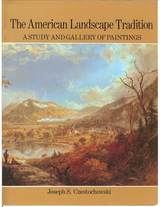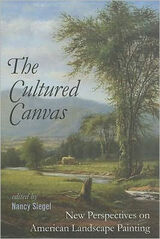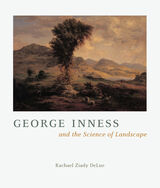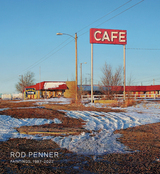4 books about Landscape painting, American

The American Landscape Tradition
a study and gallery of paintings
Joseph S. Czestochowski
International Arts, 2009

The Cultured Canvas
New Perspectives on American Landscape Painting
Nancy Siegel
University of New Hampshire Press, 2012
Written from aesthetic, sociopolitical, cultural, and literary perspectives, The Cultured Canvas explores myriad ways in which American visual culture can be evaluated through newly conceived thematic and ideological approaches. This book moves beyond our accepted notion of the oil painting on canvas to consider the term as both a literal and figurative surface upon which artists construct or construe the landscape as an intellectual, cultural, or physical entity. It provides an innovative reevaluation of traditional thought concerning the Hudson River School, Luminism, and artists of the Civil War era.
As interdisciplinary emphases are employed with increasing frequency in arts and humanities courses, the breadth and depth of topics covered in this collection will provide a much-needed text for scholars in American art history, nineteenth-century American studies, and landscape studies, in addition to serving as a complement to courses in American literature and culture.
Hardcover is un-jacketed.
As interdisciplinary emphases are employed with increasing frequency in arts and humanities courses, the breadth and depth of topics covered in this collection will provide a much-needed text for scholars in American art history, nineteenth-century American studies, and landscape studies, in addition to serving as a complement to courses in American literature and culture.
Hardcover is un-jacketed.
[more]

George Inness and the Science of Landscape
Rachael Ziady DeLue
University of Chicago Press, 2005
George Inness (1825-94), long considered one of America's greatest landscape painters, has yet to receive his full due from scholars and critics. A complicated artist and thinker, Inness painted stunningly beautiful, evocative views of the American countryside. Less interested in representing the details of a particular place than in rendering the "subjective mystery of nature," Inness believed that capturing the spirit or essence of a natural scene could point to a reality beyond the physical or, as Inness put it, "the reality of the unseen."
Throughout his career, Inness struggled to make visible what was invisible to the human eye by combining a deep interest in nineteenth-century scientific inquiry—including optics, psychology, physiology, and mathematics—with an idiosyncratic brand of mysticism. Rachael Ziady DeLue's George Inness and the Science of Landscape—the first in-depth examination of Inness's career to appear in several decades—demonstrates how the artistic, spiritual, and scientific aspects of Inness's art found expression in his masterful landscapes. In fact, Inness's practice was not merely shaped by his preoccupation with the nature and limits of human perception; he conceived of his labor as a science in its own right.
This lavishly illustrated work reveals Inness as profoundly invested in the science and philosophy of his time and illuminates the complex manner in which the fields of art and science intersected in nineteenth-century America. Long-awaited, this reevaluation of one of the major figures of nineteenth-century American art will prove to be a seminal text in the fields of art history and American studies.
Throughout his career, Inness struggled to make visible what was invisible to the human eye by combining a deep interest in nineteenth-century scientific inquiry—including optics, psychology, physiology, and mathematics—with an idiosyncratic brand of mysticism. Rachael Ziady DeLue's George Inness and the Science of Landscape—the first in-depth examination of Inness's career to appear in several decades—demonstrates how the artistic, spiritual, and scientific aspects of Inness's art found expression in his masterful landscapes. In fact, Inness's practice was not merely shaped by his preoccupation with the nature and limits of human perception; he conceived of his labor as a science in its own right.
This lavishly illustrated work reveals Inness as profoundly invested in the science and philosophy of his time and illuminates the complex manner in which the fields of art and science intersected in nineteenth-century America. Long-awaited, this reevaluation of one of the major figures of nineteenth-century American art will prove to be a seminal text in the fields of art history and American studies.
[more]

Rod Penner
Paintings, 1987–2022
David Anfam
The Artist Book Foundation, 2022
The abandoned and forgotten landscapes of rural southwestern towns are the favored subjects of Rod Penner’s paintings. His deft use of contrasts in his
images—despondency and hope, isolation and nostalgia—evokes memories of The Last Picture Show and elicits complex responses from viewers. “I’m interested in the look of things and the quality of being there,” he says. “A moment that is completely frozen with all the variety of textures; rust on poles, crumbling asphalt, light hitting the grass.”
Penner’s works are based on his photographs, digital video stills, and his experience of the rural landscapes of Texas and New Mexico. He depicts desolate, often deserted locations, the character of old houses and abandoned buildings, weather, and unique geography. His chosen scenes are infused with a cinematic quality that is the result of the exquisite light that he captures with his meticulous process. “The finished paintings should evoke contrasting responses of melancholy and warmth, desolation and serenity,” he says.
Penner’s hyperrealistic technique meticulously records both the iconic imagery and the beauty in the ashes of these once-prosperous streets and neighborhoods that still endure. The incredibly poignant scenes evoke a universalism, a collective experience seen through the lens of Americana. “You won’t find any hidden or overt socio-political meaning in my work and at the same time I hope that by utilizing what I find in the American landscape I’m able to connect to viewers on a deeper psychological level.”
[more]
READERS
Browse our collection.
PUBLISHERS
See BiblioVault's publisher services.
STUDENT SERVICES
Files for college accessibility offices.
UChicago Accessibility Resources
home | accessibility | search | about | contact us
BiblioVault ® 2001 - 2024
The University of Chicago Press









